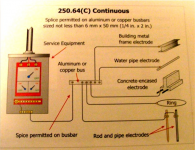overmyhead
Member
Hi folks, I was wondering if anyone had a turndown for running two EGC's from two ground rods to the main/meter panel? I'm thinking the inspector and head building official are misreading the EGC no splice requirements. Not realizing there can be multiple EGCs. Its obvious to me from 250.64(c) that there can be more than one EGC per panel. Per the use of "conductor(s)" for more than one conductor. If anyone can enlighten me here? The head official even told me two wires were better than one but still wouldn't approve it.


